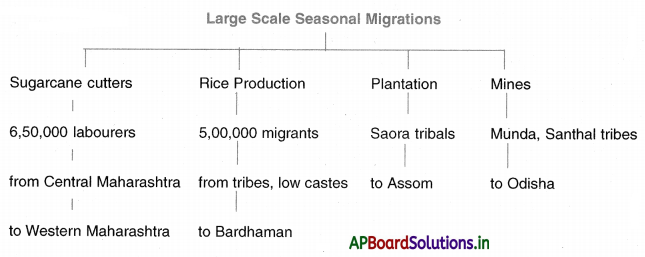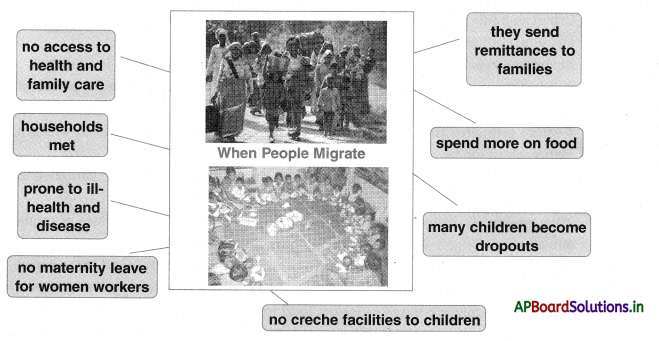Students can go through AP State Board 10th Class Social Studies Notes Chapter 8 People and Migration to understand and remember the concept easily.
AP State Board Syllabus 10th Class Social Studies Notes Chapter 8 People and Migration
→ Thousands of people move to urban locations for education, employment and better opportunities.
→ Over time people go to new places, develop relationships with new people, understand and live in a diversified culture.
→ For identifying a person as a migrant, two criteria – birthplace and last usual place of residence are used by the census.
→ In India, according to Census 2001, about 307 million people have been reported as migrants.
→ Out of the 84.2% migrated from one part of the state to another. Around 13% migrated from one state to another.
→ During the last decade (2001 – 2011), people moved from states such as Uttar Pradesh, Bihar, Rajasthan, Madhya Pradesh, Andhra Pradesh, Telangana, Chhattisgarh, Jharkhand, Odisha, Uttarakhand and Tamil Nadu to states such as Delhi, Maharashtra, Gujarat, Haryana, Punjab and Karnataka.
→ People migrate from rural areas mainly due to insufficient employment opportunities and inadequate income.
→ Most urban migrants have to work as labourers and find employment in the unorganised sector.
→ Towns also appear to offer greater freedom and somewhat less discrimination based on caste and gender.
→ Remittances – money sent by migrants from their destination – are an important means of supplementing, or generating additional incomes for the rural family.
→ Urban migrants use different job searching mechanisms depending upon their skills and educational qualifications.
→ According to national surveys (census), every fourth person in India is a migrant.
→ Some of the migrations may not be captured by census data because the period of stay is often less than six months.
→ A study estimates that about 6,50,000 labourers migrate from central to western Maharashtra for sugarcane cutting each year.
→ A large section of rural workers migrates for a short duration and particularly due to distress caused in rural areas.
→ They are mainly agricultural labourers or marginal farmers in their place of origin and mostly belong to low-income households, Dalits and Adivasis.
→ The National Commission of Rural Labour in its report in the 1990s found that uneven development and regional disparity triggered and accelerated seasonal migration.
![]()
→ When people migrate they cannot get food from fair price shops, they lack health and family care, no creche facilities and many children become dropouts.
→ One-third of the world’s 200 million international migrants moved from one developing country to another.
→ International migration from India is of two types.
- Migration of people with technical skills and professional expertise.
- Migration of unskilled and semi-skilled workers.
→ The Emigration Act, 1983 is the Indian law governing migration and employment of Indians abroad.
→ It also lays out conditions to safeguard the interests of workers emigrating for employment.
→ Migration: The movement of a large number of people from one place to another
→ Immigration: The process of coming to live permanently in a country that is not your own
→ Emigration: Leaving your own country to go and live permanently in another country
→ Seasonal: Relating to or happening during a particular period in the year
→ Border: The line that divides two countries
→ Boundary: A real or imagined tiñe that makes the limits of a country
→ Criteria: Plural of criterion
![]()
→ Criterion: A standard or principle based on which decision is made
→ Birthplace: Place where the person was born
→ Last usual place of residence: A place where the person had stayed continuously for a period of six months or more
→ Unorganised sector: Unorganised sector refers to the household used production activities, small and tiny sectors of the industry like handicrafts, handlooms, beedi making, etc.
→ Organised Sector: Large scale industries and agricultural units with a defined pattern of production, distribution and employment are referred to as an organised sector, e.g: textiles, automobiles, etc.
→ Service activities: Transport and communication, financial institutions, banking and insuranc&and public administration activities
→ Remittances: Money sent by migrants from their destination
→ Urban migrants: The peopÍe who are migrated to urban areas (usually from rural areas but sometimes from towns also)
→ Seasonal migrants: The people who are migrated temporarily (for less than 6 months)
→Kopi: A small conical hut made of bamboo mat and poles
→ Gadi centre: The settlement with 50 – 100 kopis
→ Tyre centre: The settlement with 200 – 250 kopis
→ Agricultural labourers: The labourers who work in agriculture and allied activities (unskilled and landless)
![]()
→ Marginal farmers: The farmers who own land less than or equal to 2.5 acres

